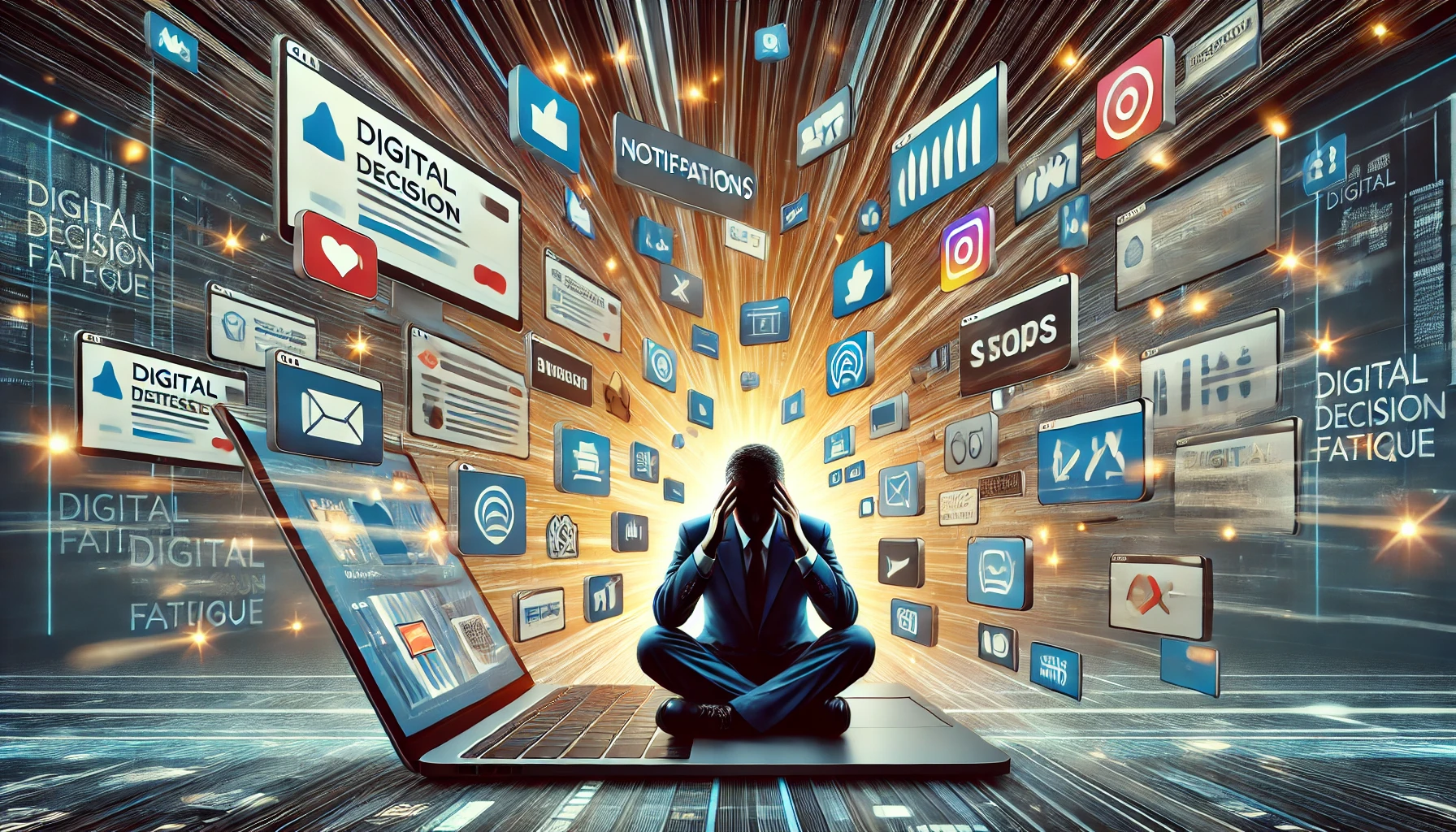The Psychology of Digital Decision Fatigue: How Technology Overwhelms Our Minds. In today’s digital age, where options abound and attention is constantly in demand, decision-making has become a mentally exhausting process. Known as digital decision fatigue, this phenomenon highlights how the abundance of choices presented by technology can deplete mental energy, lower productivity, and even impact well-being. But why does this happen, and how can we combat it in a world where technology dominates our daily lives? This deep dive explores the roots of decision fatigue, its psychological and practical effects, and strategies for reclaiming mental clarity and focus.
Understanding Digital Decision Fatigue
1. The Definition
Decision fatigue refers to the deteriorating quality of decisions made after a long session of decision-making. In the digital context, this occurs when constant notifications, app switching, and endless choices – be it in content, communication, or work tools – overwhelm the brain. Unlike physical fatigue, digital decision fatigue can be harder to identify, often manifesting subtly as procrastination, avoidance, or stress.
2. Real-Life Examples
Consider these scenarios:
- Streaming Overload: You open your favorite streaming platform but spend 20 minutes scrolling through hundreds of options, unsure of what to watch. Eventually, you settle on something, but the experience feels unsatisfying.
- App Overchoice: With dozens of apps available for task management, fitness tracking, or photo editing, you spend hours comparing features instead of getting started on your actual task.
- Notification Management: You receive an influx of alerts – emails, social media updates, and reminders – forcing you to decide whether to respond, ignore, or snooze each one.
These small but frequent decisions accumulate, taxing the brain’s energy reserves and leaving you mentally exhausted.
The Neuroscience Behind Digital Decision Fatigue
1. The Role of the Prefrontal Cortex
The prefrontal cortex is the brain’s decision-making powerhouse, handling complex cognitive tasks such as planning, evaluating, and prioritizing. However, it has finite energy. As you make decisions throughout the day, this mental resource depletes, leading to poorer judgment and slower cognitive performance.
2. Dopamine and Instant Gratification
Many digital decisions are designed to trigger dopamine release, the brain’s “reward” chemical. Each swipe, like, or notification feels like a small accomplishment, encouraging repeated engagement. This constant stimulation, while gratifying in the short term, contributes to long-term mental fatigue.
3. The Cognitive Load of Digital Multitasking
Switching between tasks – answering emails, scrolling social media, and toggling between work apps – demands frequent decision-making. Each transition, no matter how small, adds to the cognitive load, intensifying fatigue over time. This aligns with the findings discussed in Science of Focus: Train Your Brain to Stay Productive, which emphasizes the mental strain of constant task-switching.
The Psychological Impact of Digital Decision Fatigue
Decision fatigue extends beyond productivity, affecting mental health and behavior in profound ways:
1. Stress and Anxiety
The constant need to evaluate options can create a sense of overwhelm, leading to stress and anxiety. This is particularly true for individuals who feel pressure to make “perfect” choices, whether it’s selecting a vacation destination or choosing the best productivity app.
2. Procrastination
When mental energy is depleted, people are more likely to avoid decisions altogether. This procrastination can result in missed opportunities or rushed choices later, further compounding stress.
3. Impulsive Decision-Making
Conversely, decision fatigue can lead to impulsive behavior. For instance, instead of carefully selecting a streaming show, you might default to the first option, even if it doesn’t align with your preferences.
For insights into how technology influences mental health, explore The Neuroscience of Smartphone Addiction.
How Digital Platforms Exacerbate Digital Decision Fatigue
1. Choice Overload
Many digital platforms pride themselves on offering a vast array of options. While this abundance is appealing, it also forces users to make more decisions, each carrying its own cognitive cost.
2. Continuous Engagement Design
Features like infinite scrolling, autoplay, and notification badges are designed to keep users engaged. While these features enhance usability, they also demand constant decisions, from whether to keep scrolling to what content to prioritize.
3. Fragmented Attention
Multitasking across multiple apps, tabs, and devices fragments focus and increases the number of decisions you must make in a short span of time. This aligns with the trends explored in The Rise of the Quiet Internet, which advocates for streamlined digital experiences.
Practical Strategies to Combat Digital Decision Fatigue
1. Simplify Your Digital Environment
Reduce clutter by uninstalling unnecessary apps, unsubscribing from irrelevant emails, and curating your social media feeds. The fewer options you have to sift through, the easier it becomes to focus.
2. Automate Routine Decisions
Automation tools can handle repetitive tasks, such as email filters, recurring reminders, and AI-driven prioritization. These tools save mental energy for more meaningful decisions.
3. Set Daily Routines
Establishing routines eliminates the need to make frequent decisions. For example, dedicating specific times for checking emails or scheduling focused work sessions helps conserve mental resources.
4. Use Decision-Making Frameworks
Frameworks like the Eisenhower Matrix (urgent vs. important) or pros-and-cons lists can help simplify complex choices, making them less overwhelming.
5. Take Regular Breaks
Short breaks between decision-heavy tasks allow the brain to recharge. Techniques like the Pomodoro Method can help you structure work intervals to prevent burnout.
For broader strategies to maintain focus, read 7 Powerful Ways to Boost Your Focus.
The Role of Tech Companies in Reducing Decision Fatigue
Tech companies are beginning to recognize their role in decision fatigue and are introducing features to alleviate it:
- AI-Powered Recommendations: Personalized suggestions based on user behavior can reduce the need to sift through endless options.
- Minimalist Design: Apps with streamlined interfaces and limited choices help users focus on the essentials.
- Notification Management: Smarter notification systems prioritize critical alerts while suppressing less relevant ones.
Conclusion
Digital decision fatigue is a growing challenge in a world of endless options and constant connectivity. By understanding its psychological roots and taking deliberate steps to simplify your digital environment, you can regain control over your mental energy and focus. Remember, every decision you eliminate is an opportunity to direct your energy toward what truly matters.
To further explore managing the digital world effectively, consider reading Balanced Digital Diet and 5 Surprising Benefits of Practicing Digital Minimalism.





Leave a Reply